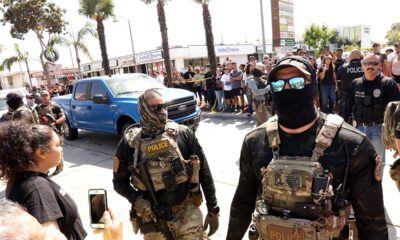California
California Courthouse Bombing Suspect Charged With Using Weapon Of Mass Destruction—Faces Possible Life Sentence

Topline
A Santa Barbara County man accused of bombing a courthouse in Santa Maria, California, last month and injuring at least five people was charged with additional criminal counts Wednesday and now faces the possibility of life in prison if convicted on all charges.
Key Facts
Nathaniel McGuire, 20, was charged by the Justice Department with one count of using a weapon of mass destruction and one count of possessing unregistered destructive devices, tacking onto a prior federal charge accusing him of maliciously damaging a building by means of explosive.
Prosecutors allege McGuire entered a courthouse, threw a bag into its lobby that exploded, injuring at least five people, and left the courthouse on foot.
After being detained by law enforcement, McGuire allegedly yelled that the government took his guns and that “everyone needed to fight, rise up and rebel,” according to a statement from the U.S. Attorney’s Office for the Central District of California.
Law enforcement searched McGuire’s car and found a shotgun, rifle, ammunition, 10 Molotov cocktails and a suspected bomb, with prosecutors reporting McGuire told law enforcement he planned to go back to the courthouse with the firearms to kill a judge.
McGuire faces a minimum of seven years in federal prison if he is convicted of all charges, and a maximum of life in prison.
McGuire has remained in custody since the Sept. 25 attack and will be arraigned in Los Angeles this Friday.
Get Forbes Breaking News Text Alerts: We’re launching text message alerts so you’ll always know the biggest stories shaping the day’s headlines. Text “Alerts” to (201) 335-0739 or sign up here.
Crucial Quote
“The new charge of using a weapon of mass destruction underscores how seriously we are treating this misconduct and my office’s determination to hold accountable those who seek to bring violence upon our courts, law enforcement personnel, and the public,” U.S. Attorney Martin Estrada said in a statement.
Key Background
Those injured by the bombing suffered from non-life-threatening injuries and were released by the hospital the same day. The Santa Barbara County Sheriff’s Office said McGuire’s motivation appeared to be linked to his arrest in July, when he was arrested for possession of a loaded and concealed revolver not registered to his name. Undersheriff Craig Bonner told reporters after the bombing that though his office believed the attack stemmed from frustration over his arrest, law enforcement was “not absolutely ruling out that there is something larger at play.”
Further Reading
Video shows screaming bomb suspect being dragged outside Santa Maria courthouse (San Luis Obispo Tribune)
California Courthouse Bombing Leaves 5 Hospitalized, One Suspect Detained (Forbes)

California
One Of California’s Wealthiest Suburbs In 2025 Has Small-Town Charm And A Fun Social Scene Outside LA – Islands

Coto de Caza in Orange County, California, about an hour south of Los Angeles, may not be a household name. But viewers of “The Real Wives of Orange County” might recognize the wealthy, gated residential community as the former home base of the glitzy Bravo reality series. While stars of the show — currently in its 19th season — now live in other affluent areas, the imagery of Coto de Caza is still appealing for those contemplating a luxurious move. Coto boasts a private setting where high-profile celebrities, executives, and wealthy professionals live amid abundant open space, well-regarded schools, community events, a family-friendly atmosphere, and easy access to the county’s bounty. Indeed, in this well-to-do development of about 15,363 people, where the mean household income is $232,470 (more than double the state’s average), the most recent median list price of a single-family home was $2 million. There are splashier compounds in Coto, including the late real estate mogul William Lyon’s home selling for $125 million, which includes 20 bathrooms.
These prices are a long way from the area’s humble origins of barley fields and grazing sheep, according to the Los Angeles Times. Once a private hunting lodge, the area’s first homes were built in 1975, eventually transforming into a 5,000-acre master-planned community with about 4,000 homes and condominiums. Nestled against the Cleveland National Forest and just east of the SR 241 toll road, Coto de Caza strives to offer residents not just a home, but a lifestyle. Recreation is never far with area baseball fields, basketball courts, volleyball courts, parks, and picnic areas. Outdoor pursuits continue at the adjacent Thomas F. Riley Wilderness Park, a 544-acre wildlife sanctuary filled with groves of Western Sycamores and Coast Live Oaks and five miles of trails for hiking, biking, and horseback riding.
Golf and mingle
A big attraction to the development is the 36-hole Coto de Caza Golf & Racquet Club, a central hub offering youth summer camps for kids and social events like trivia nights, comedy nights, and brunch with Santa. A yearly social membership can cost $2,880 with $180 in monthly dues. A golf upgrade can hike the initiation fee up to $30,000 with $750 monthly dues. Joining the club is optional, but your monthly Homeowners Association (HOA) fees aren’t. Those range from $300 to $475, and cover 24-hour manned guard gates, daily patrols, and landscape maintenance of common areas. A cheaper ticket to fun is connecting with neighbors for poker nights, movie screenings, and monthly mixers.
This is a neighborhood where you can stay put for your child’s entire education. Parents send their kids to top-notch schools, including Wagon Wheel Elementary, Las Flores Middle, and Tesoro High, in the Capistrano Unified School District, all within a short 2.5 to 5.5 mile drive away. Grocery shopping also is fairly close, about 10 minutes to Rancho Santa Margarita stores such as Ralph’s and Trader Joe’s. To really shop, like at Bloomingdale’s and Gucci, the Valhalla of retail — South Coast Plaza — and the vibrant arts city of Costa Mesa are just a 30-minute drive. Plus the glorious Pacific Ocean is about 17 miles away in breath-taking Laguna Beach.
Coto de Caza’s charms are many. A few cons to keep in mind: With a location about 10 miles inland from Interstate 5, Coto de Caza is more remote so commutes may take longer; busy professionals need their shut-eye so nightlife peters out by 9pm; and wildfire risks mean finding insurance can be a challenge. For a buzzier locale, check out the iconic coastal escape of nearby Newport Beach.
California
Disneyland, California Adventure has new treats, drinks to try in 2026
Siblings with hearing loss have magical ASL chat with Buzz Lightyear
A trip to Disneyland in Anaheim, CA, turned magical for siblings Jabez and Evelyn when they met Buzz Lightyear, who knew American Sign Language.
A boozy matcha beverage and pork belly bao buns are among the many new treats coming to Disneyland and Disney California Adventure, adding to the dizzying number of things you’ll want to try amid events like the return of Sweetheart’s Nite to the debut of “Bluey.”
Disney Parks Blog unveiled the lineup of dishes, desserts and drinks coming to both barks in Anaheim beginning on different dates throughout January. Among the major news is a menu change at Flo’s V8 Cafe at Cars Land at California Adventure; that includes a cheeseburger topped with caramelized onions and a pepperoncini cheese sauce and chicken and waffles.
The new items across both parks take inspiration from cuisines across the globe. Here’s a look at just some of the new options coming to both parks and where you’ll be able to find them, plus a look at the calendar of events for both parks in 2026.
Disneyland food coming in 2026: 8 options to know
- Lemon chiffon tea: A sweet tea topped with lemon chiffon foam at the Jolly Holiday Bakery Cafe at Main Street, U.S.A.
- Yuzu lemonade: Lemonade with a “touch” of floral yuzu juice and a rainbow jelly topping at the Harbour Galley in New Orleans Square.
- Sweet heat beignet chicken sandwich: A fried chicken sandwich with buffalo sauce and slaw on beignets served with collard greens and house-made pickles at Tiana’s Palace in New Orleans Square.
- Andouille sausage po’boy: Roasted andouille sausage, lettuce, tomatoes, mayonnaise and a rémoulade sauce served with collard greens and house-made pickles at Tiana’s Palace in New Orleans Square.
- Duo tacos with carne asada or chicken: Corn tortillas with tomatillo sauce and pickled onion habanero served with tortilla chips and salsa fresca at the Rancho del Zocalo Restaurante in Frontierland.
- Gaston burger: A beef patty with pastrami, cheese, pickles, sauteed onions and bell peppers with pepperoncini at the Red Rose Taverne in Fantasyland.
- Tropical slushy: A passion fruit, orange, guava and lychee syrup with a chile-lime rim beverage at Bengal Barbecue in Adventureland.
- Peanut butter brownie slice: A brownie slice topped with peanut butter mousse, melted peanut butter and chocolate at the Jolly Holiday Bakery Cafe at Main Street, U.S.A.
California Adventure food coming in 2026: 7 options to know
- Strawberry, hazelnut, chocolate & pistachio Mickey Shake: A strawberry shake with pistachio whipped topping, fried kataifi and chocolate sauce at Schmoozies! in Hollywood Land.
- Soju-matcha cocktail: Topped with honey cold foam and honey cereal at Schmoozies! in Hollywood Land.
- Mickey-shaped cinnamon roll macaron: A cinnamon roll macaron shell filled with cream cheese buttercream and cinnamon caramel at the Cappuccino Cart at San Fransokyo Square.
- Infinity cream puffs: Six mini cream puffs in different flavors, from raspberry, cotton candy and key lime, at Terran Treats in the Avengers Campus.
- Pork belly bao bun: A bao bun with pickled onions, crispy chicharron and calamansi citrus aioli at the Lamplight Lounge at Pixar Pier.
- Frozen banana mudslide cocktail: A cocktail of vanilla vodka, Kahlua, Baileys Irish Cream, banana liqueur and half and half at Wine Country Trattoria in the Performance Corridor.
- Chocolate Japanese-style fluffy cheesecake: Topped with cherry sauce and available at Aunt Cass Café at the San Fransokyo Square.
Lunar New Year, Sweetheart’s Nite and ‘Bluey.’ Disneyland, California Adventure 2026 events
The Disneyland Resort is continuing its 70th anniversary celebration through Aug. 9. Here’s a look at just some of the new and returning events coming throughout the year:
- Sweetheart’s Nite at Disneyland: The Valentine-themed event that brings out specialty treats and drinks and late-night festivities returns on Jan. 22, 25, 27 and Feb. 3, 5, 8, 10, 12, 17. This is a separately ticketed event.
- Lunar New Year at California Adventure: Ring in the Lunar New Year Jan. 23-Feb. 22.
- Anaheim Ducks Day at California Adventure: Hockey fans can celebrate the Anaheim Ducks at this themed day, complete with appearances by players from the NHL team on Feb. 22.
- 70 Years of Favorites at Disneyland: Experience “nostalgic entertainment” and “iconic Disney characters” on March 3 and 5. This is a separately ticketed event.
- California Adventure Food & Wine Festival: Enjoy limited-time food offerings, culinary demos and other foodie-themed experiences from March 6-April 27.
- “Bluey” at Disneyland: “Bluey’s Best Day Ever!” debuts March 22 at the Fantasyland Theatre, where the popular children’s show “Bluey” is brought to life in an interactive show.
- Disney Channel Nite at Disneyland: “Pay tribute to iconic childhood shows and characters” on April 12, 14 and 16. This is a separately ticketed event.
- “Star Wars” Nite at Disneyland: Celebrate “Star Wars” with this after-hours event on April 28 and 30 and May 4 and 6. This is a separately ticketed event.
- Pride Nite at Disneyland: Celebrate Pride Month at Disneyland on June 16 and 18. This is a separately ticketed event.
- D23 Day at Disneyland Resort: D:23: The Ultimate Disney Fan Event kicks off with D23 Day at the Disneyland Resort on Aug. 13.
- Oogie Boogie Bash at California Adventure: Show up in costume for a Halloween party on select nights throughout August, September and October. This is a separately ticketed event.
- Halloween Time at Disneyland: Festive decor and seasonal attractions ahead of Halloween returns Aug. 21-Oct. 31.
- Plaza de la Familia at California Adventure: The annual celebration of Día De Los Muertos returns Aug. 21-Nov. 2.
- Holidays at the Disneyland Resort: Festive, seasonal decor and foods return Nov. 18.
Paris Barraza is a reporter covering Los Angeles and Southern California for the USA TODAY Network. Reach her at pbarraza@usatodayco.com.
California
Rain continues in parts of California reeling from flooding and high tides – WTOP News

CORTE MADERA, Calif. (AP) — Crews cleared mud from key California highways as forecasters warned Sunday that more thunderstorms were…
CORTE MADERA, Calif. (AP) — Crews cleared mud from key California highways as forecasters warned Sunday that more thunderstorms were on the way after downpours and high tides caused flooding, road closures and rescues of people trapped in cars.
Five northern counties remained under a flood watch, with up to three inches (7.6 cm) of rain possible through Monday night in areas that have been drenched off and on since around Christmas, said the National Weather Service office in Eureka. At least a foot (.3 meters) of snow was likely in the mountains.
To the south near the San Francisco Bay Area, waters were slowly receding after roadways from Sausalito to San Rafael were flooded during heavy rain that coincided with record-breaking “ King Tides.” Such tides occur when the moon is in its closest position to the Earth, creating a stronger gravitational pull.
Some people kayaked along swamped streets, while others waded through water above their knees. Authorities were called to assist when cars got stuck in water as high as 3 and 4 feet (1.1 and 1.2 meters), Marin County Sheriff’s Sgt. Michael Dobbins said Saturday.
“I’ve been around here for the King Tides and I’ve never seen it this high. Never,” Jeremy Hager of San Rafael told KTVU-TV.
Flooding was reported across Marin, Sonoma, Alameda, San Mateo and San Francisco counties.
While the tides were waning, lingering thunderstorms on Sunday could cause additional problems throughout low-lying areas, forecasters said. “For anyone driving, slow down and allow extra time to reach your destination,” the Bay Area office of the weather service warned on social media.
Farther south in Santa Barbara County, a key highway was reopened Sunday after it was blocked for most of the weekend near Goleta due to a series of mudslides. A man died after he was swept into a creek during the storm, the sheriff’s office said Saturday.
Parts of Santa Barbara County received more than four inches (10 cm) of rain over two days, the weather service said Sunday.
After a mostly dry autumn, California has been hit by a series of powerful winter storms that brought the wettest holiday season to the state in years.
Copyright
© 2026 The Associated Press. All rights reserved. This material may not be published, broadcast, written or redistributed.
-

 World1 week ago
World1 week agoHamas builds new terror regime in Gaza, recruiting teens amid problematic election
-

 Indianapolis, IN1 week ago
Indianapolis, IN1 week agoIndianapolis Colts playoffs: Updated elimination scenario, AFC standings, playoff picture for Week 17
-

 News1 week ago
News1 week agoFor those who help the poor, 2025 goes down as a year of chaos
-

 World1 week ago
World1 week agoPodcast: The 2025 EU-US relationship explained simply
-

 Business1 week ago
Business1 week agoInstacart ends AI pricing test that charged shoppers different prices for the same items
-

 Business1 week ago
Business1 week agoApple, Google and others tell some foreign employees to avoid traveling out of the country
-

 Politics1 week ago
Politics1 week ago‘Unlucky’ Honduran woman arrested after allegedly running red light and crashing into ICE vehicle
-

 Technology1 week ago
Technology1 week agoChatGPT’s GPT-5.2 is here, and it feels rushed





















